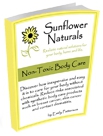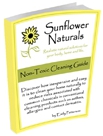With the recent increase in consumer education regarding health risks associated with chemical in consumer goods, how can we choose safe, or safer, products for cleaning and body care?
Many people are educating themselves regarding the ingredients in the products they use for cleaning and body care. As more studies are completed, it is becoming apparent that certain ingredients increase the risk of developing cancers, diabetes, allergies, asthma, male infertility/reduce fertility, female reproductive disorders, and other health problems. One of the questions most frequently asked is how to find safe, or safer, products.
It might seem as though reading labels is the best way to determine if a product is safe. However, the task of researching each ingredient on body care products is quite overwhelming. Cleaning product manufacturers are not required to list ingredients on the label. Obtaining a list of ingredients on cleaning products requires online research or a call to the manufacturer. In addition, not all ingredients are disclosed due to protection of trade secrets. Also, manufacturing by-products, such as formaldehyde and 1,4-dioxane, both of which are classified as 'likely carcinogens' by the Environmental Protection Agency, do not have to be disclosed on product labels.
Choosing to trust name-brand products also seems like a way to choose safe products for your family. However, companies like Johnson and Johnson continue to allow harmful chemicals in their products, it seems that companies really don't care much about their customers.
|
|
For example, ingredients such as methylisothiazolinone, which is potentially toxic to the nervous system, parabens which are banned in many other countries due to the increased risk of developing breast and reproductive cancers and 'fragrance', comprised of a blend of phthalates which studies repeatedly show dramatically increase the risk of developing asthma, allergies and respiratory conditions and mineral oil, which is associated with a variety of cancers - including skin cancer. And these are just the chemicals on the label and don't include the manufacturing by-products, such as formaldehyde and 1,4-dioxane that are likely carcinogens or the chemicals that are not required to be disclosed to protect trade secrets.
Of the 84,000 chemicals in production today, 17,000 of them are not required to be disclosed to consumers. More than 62,000 of the chemicals in production today were in production prior to the 1976 Toxic Substances Control Act, and are 'grandfathered', or considered 'safe' without ever being tested for human health hazards. Only 200 of these have ever been studied, which are chemicals such as dioxins, formaldehyde and benzene - which are all extremely hazardous to the health of humans and animals. After intense public pressure, 150 of the chemicals that were on the list of chemicals protected by 'trade secret', were removed from the list and made available to the public. This still leaves close enough to 17,000 chemicals undisclosed, and at least 62,000 in our products without having been studied.
As more people question ingredients, and learn the risks - the questions remain: How to choose safe products? Which brands are safe? The simple truth is that there is no way to know until there is full disclosure of ingredients. Choose to replace as many cleaning and body care products with simple, inexpensive, chemical-free natural solutions as possible. That's about all you can do at this time to avoid the risks associated with ingredients in currently available conventional products.
|



